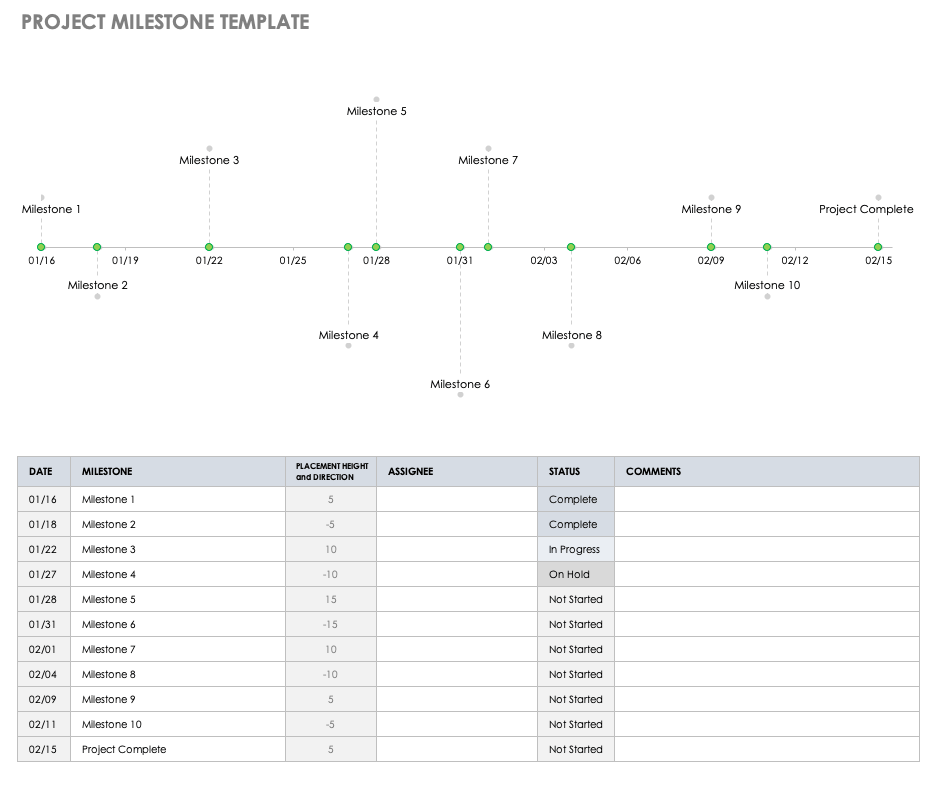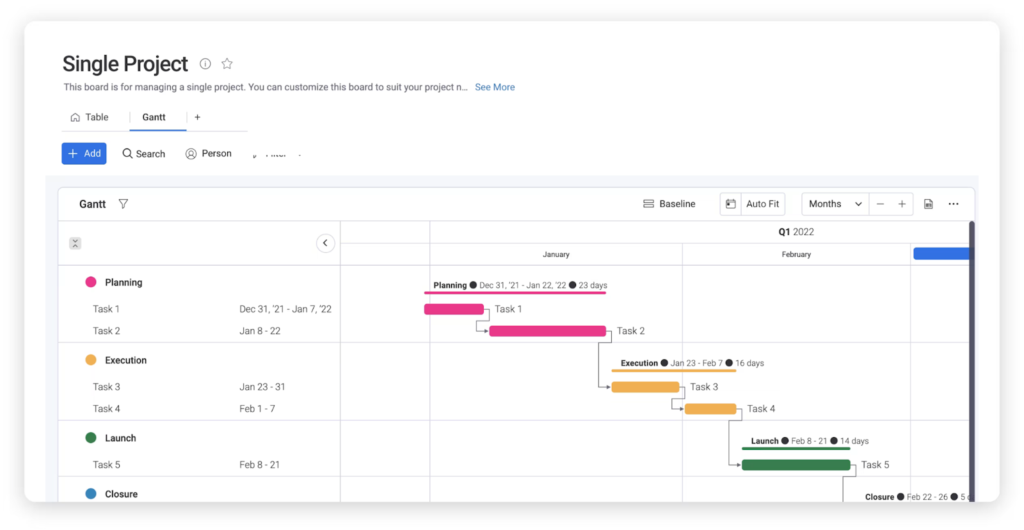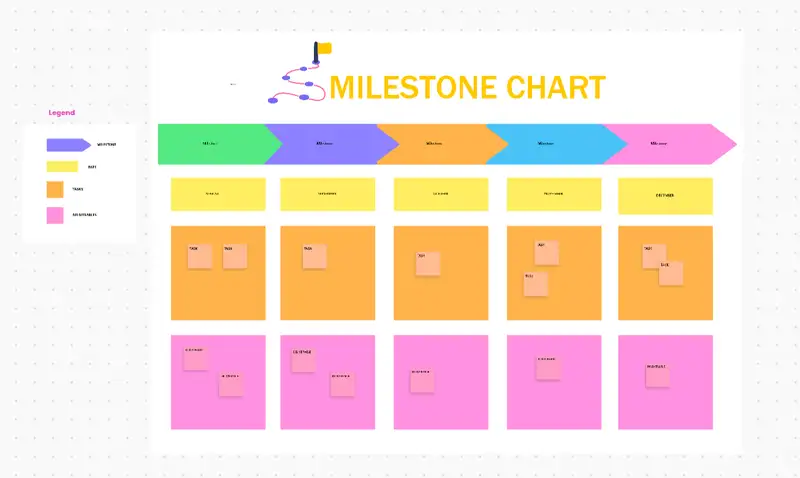Key takeaways
Milestones in project management serve as handy reference points that mark various events throughout the project life cycle. Ranging from the simplest and most rudimentary of events to larger goals and anything in between, project milestones provide a quantifiable way to gauge progress and productivity over the course of time. While this is a great way to define project milestones in a nutshell, the process of establishing and achieving these milestones is a little more complicated.
Examples of Project Milestones
Project management milestones can revolve around many different elements. Some of the most popular examples of milestones are centered on the various project phases, major tasks or events, or specific project deliverables.
Project Phases
As projects progress through the five phases of project management, it’s effective to establish milestones based on these stages. This is especially true for projects that move forward in a linear fashion, like those using the waterfall methodology.
As an example, below are milestones for a project in the event management industry, divided into the different stages of the project life cycle:
| Project Phases | Specific Milestone |
| Conception and initiation | Deliver the event pitch and proposal by June |
| Definition and planning | Complete the event planning phase between July and October |
| Launch and execution | Launch the event between November and December |
| Performance and control | Maintain the event until the end of January |
| Project closure | Complete the final event evaluation in February |
Conversely, milestones within a software development project might include:
| Project Phases | Specific Milestone |
| Conception and initiation | Identify a specific problem that is solved by your software in January |
| Definition and planning | Create technical specifications for the various features by February |
| Launch and execution | Complete coding of your software and launch the first version by September |
| Performance and control | Provide various tweaks, upgrades, and bug fixes until September of the next year |
| Project closure | Establish an end date for software updates and upgrades |
Major Tasks or Events
Conversely, you can create project management milestones based on major tasks or events that should occur during the project lifecycle. However, tasks and events can — and often are — disrupted during the average project lifecycle. Because of this, it’s important to anticipate potential disruptions and come up with appropriate contingency plans in case something does go awry.
Here are examples of project milestones based on major tasks or events within the project life cycle:
- Target date for a product launch
- Pre-planned sales events, trade shows, and conventions
- Prior to extended holiday breaks
- Scheduled system outages or maintenance periods
For best results, make sure to choose tasks and events that are the most relevant to the project at hand and are attainable by your team.
Specific Project Deliverables
You can also set milestones based on specific project deliverables. This is often the best approach when managing a software development project using the Agile methodology. Since the Agile approach provides plenty of room for the project to change and evolve over time, it’s helpful to correlate your project management milestones with project deliverables such as new software features, updates, or bug fixes.
Importance of Project Milestones
Project milestones are more than just progress checkpoints. Here’s how it can help in ensuring project success.
- Helps identify potential gaps, bottlenecks, and shortcomings: Working from milestone to milestone helps your entire team forecast potential gaps, bottlenecks, and shortcomings while making it easier for them to tackle issues as they arise.
- Makes resource allocation easier: Establishing clear milestones at the beginning of a project makes it easier to secure and allocate the necessary resources — especially in the case of long-term or large-scale projects.
- Aids in task prioritization and delegation: Clarifying milestones that need to be reached gives skilled PMs the added advantage of prioritizing and delegating tasks ahead of time.
- Ensures alignment between teams and stakeholders: In some cases, it can be difficult to align the expectations of stakeholders with the abilities of your team. Not only do project milestones give you a tangible means of reporting how close to or far from completion your project is, but they can help stakeholders better understand the needs of your team.
- Helps teams avoid scope creep: Even the most meticulously planned projects can suffer from scope creep. Although some will argue that there is no real way to eliminate scope creep completely, project milestones can help you identify scope creep as — or before — it happens.
The importance of milestones in project management cannot be underestimated. In order for your milestones to be effective, however, they need to be created with consideration of several factors and the involvement of all stakeholders.
How to Create Project Milestones
Here are things to keep in mind when creating milestones for your team.
- Understand the project goals. It’s critical that you clearly understand the project’s final goals before creating any milestones. Failure to do so could result in milestones that are irrelevant or unattainable.
- Break down the project into phases, tasks, and events. Once you understand the different phases of the project life cycle, it’s easy to attach milestones to each phase. Look for important tasks and events that can serve as additional milestones too.
- Link milestones to approvals and reviews. Milestones are often linked to project phases, events, or deliverables, but gaining approvals and successful reviews also makes significant milestones.
- Compare milestones with your project schedule. Take the time to compare your established milestones directly to the project schedule. Not only does this help you avoid gaps and conflicts, but it can also help in prioritization, delegation, and resource allocation.
- Maintain accountability. Remember, your success is only determined by the success of your team. If your project team fails to meet your established milestones, it’s time to re-evaluate your methodology and make the necessary adjustments.
- Celebrate success. This could come in the form of monetary bonuses, additional PTO, or even a simple “thank you.”
Read more: 20 Key Project Management Questions to Ask for Project Success
How to Visualize Project Milestones

Milestones in project management can be visualized in a variety of ways. Ideally, it’s best to visualize milestones in a way that can be easily understood by team members and key stakeholders.
Some examples include:
- Project checklist: Perhaps the most rudimentary way of visualizing project milestones, the project checklist approach is often left by the wayside in favor of visualizations that are newer, easier to read, and more effective.
- Project management timeline: A project management timeline provides a straightforward means of scheduling project tasks, events, and milestones according to the project’s final deadline. It’s best used when there is a definitive end date for the project at hand.
- Gantt chart: The purpose of a Gantt chart is to monitor tasks, resources, and schedules within a project. As such, it’s one of the most common ways of visualizing project milestones.
- Kanban board: A popular alternative to the Gantt chart, a kanban board helps you track project milestones that are upcoming, completed, or currently ongoing.
- Work breakdown structure: As the name implies, the work breakdown structure (WBS) divides the project into smaller, easily digestible chunks, which is ideal for long-term projects or projects that have many different tasks that are all dependent on one another.
- Basic spreadsheets: Finally, spreadsheets can be used as a basic way to visualize your project milestones. These can be as simple or as detailed as you want — the only issue is the manual updating required to track the status of individual milestones.
Tips for Managing Project Milestones
Proper tracking or monitoring of project milestones is a great way to ensure their completion while also driving success for the entire project.
- Communicate with stakeholders and team members: Make sure to communicate with your teammates and key stakeholders. If a milestone needs to be updated, make sure to relay these changes properly.
- Adjust milestones (and expectations) as needed: The best project milestones can easily be adjusted as needed. Whether your team is having difficulty meeting the milestones you’ve created or they’ve achieved them early, don’t hesitate to make changes as you see fit.
- Monitor progress and productivity: Remember to monitor your progress regularly to see how close you are towards each of your milestones. This is so you can gauge whether your project is progressing as expected and on schedule and so you can address any challenges that may be hindering your progress.
- Evaluate and report the results: Create a final project evaluation and report the results. Identifying your successes while taking accountability for your failures is an effective way to build your integrity and grow as a project manager.
Project Milestone Templates
Key milestones in project management are much easier to track when using a template. There are plenty of options to choose from, so pick the one that works best for you and your team.
Basic project milestone template
Smartsheet offers a variety of free project milestone templates, including a basic milestone template, a project timeline with milestones, an acquisition milestone schedule template, and more.

Project management timeline and milestone template
monday.com provides a free milestone template that includes a comprehensive timeline.

Project management milestone chart template
The team at ClickUp has put together a free and easy-to-understand milestone chart template, which helps you establish and visualize milestones, prioritize tasks, and monitor progress.

Common Mistakes in Project Milestones Creation
Although you might not be able to account for every possible scenario, knowing the most common pitfalls and mistakes in creating project milestones is a good start.
- Creating too many (or not enough) milestones: Try to be selective when creating milestones, as too many can quickly lead to confusion amongst teammates and stakeholders. Conversely, setting too few milestones makes it hard to gauge project progress.
- Not clarifying objectives related to specific milestones: Teammates need to know exactly what’s expected of them, while stakeholders need to know exactly what to expect. Creating milestones that are overly vague or generic will be difficult to complete and even more difficult to verify.
- Failing to modify and optimize milestones over the project lifecycle: The best project milestones aren’t set in stone. As a PM, it’s your job to monitor your team’s performance and adjust milestones as necessary.
- Ignoring scope creep: Failing to tackle scope creep head-on is one of the quickest ways to miss your milestones, and in some cases, it could derail the entire project.
It’s important to remember that some mistakes are unavoidable, so learning how to recognize these mistakes in real time and how to avoid them in the future is crucial.
FAQs
Bottom Line
Milestones in project management are useful for a number of reasons. Not only do they give the project team a way of tracking the project throughout its life cycle, but they also help skilled project managers spot potential bottlenecks and implement corrective actions ahead of time. When used correctly, milestones in project management also make it easy to assess priorities, monitor deadlines, and communicate with teammates and key stakeholders alike.





